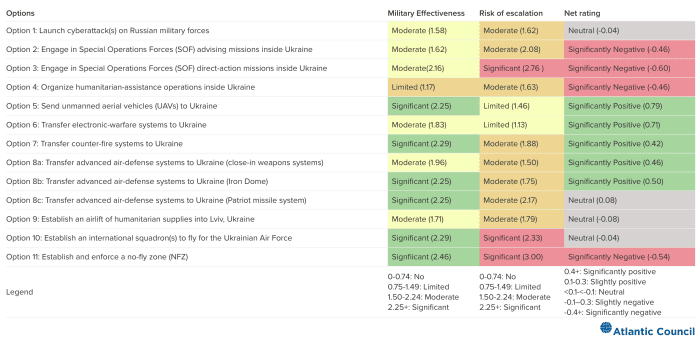This post was originally published on this site
Like almost all observers of the mad Russian invasion of Ukraine, we have been shocked and angered by the images of indiscriminate Russian attacks that have killed hundreds, and likely thousands, of innocent Ukrainian civilians.
It is difficult to look at those images and not wish the United States and NATO would do more to contribute to Ukraine’s self-defense and help prevent their subjugation at the hands of Russian President Vladimir Putin.
Until now, the United States and its NATO allies have been striving to strike a balance between “doing more” to support Ukraine against the risks that certain forms of increased intervention could spiral to direct armed conflict between Russia and NATO. Governments in Washington and NATO capitals must make difficult decisions on how they will continue or strengthen support to Ukraine while managing escalation risks with Moscow.
Last week we conducted a survey of more than three dozen national security professionals with the objective of evaluating multiple options for expanded U.S./NATO support for Ukraine. The purpose was to inform the ongoing alliance debate about increasing national and NATO support to Kyiv and providing an informed assessment of the relative benefits and risks of specific military options.
The results were enlightening and informative: Respondents generally favored the transfer of military hardware to Ukraine over any operations conducted by the U.S. and NATO allies inside of or flying over Ukraine.
Options that could rapidly increase Ukrainian combat capability and capacity while mitigating the risk of a Russian escalatory response scored highest in estimated military effectiveness and limited risk of escalation to armed conflict between Russia and NATO. Specifically, the transfer of unmanned aerial vehicles (UAVs, commonly referred to as “drones”) had the most positive net rating, followed by the transfer of electronic warfare equipment, air defense assets and counter-ground-fire capabilities.

Atlantic Council
Based on the survey results, the most appealing option was for the United States and NATO to expand deliveries of the TB-2 Bayraktar UAV that the Ukrainian forces have been using to great effect throughout the war with Russia.
In 2019, Ukraine purchased six Bayraktars for nearly $70 million, but that deal included weapons, maintenance equipment and spares. The actual cost of each aircraft is assessed to be in the $1 million-$2 million range. According to the State Department, the United States has now provided more than $1 billion in military equipment to Ukraine this calendar year.
Support for increased military aid to Ukraine has strong public support and, more importantly, broad bipartisan support.
The primary question is not if the Biden Administration can get more security assistance funds to Ukraine through Congress, but what form that assistance takes. A highly cost-effective use of additional security assistance would be in the continued procurement and delivery of Bayraktars to Ukraine throughout the duration of the conflict.
In addition to the Bayraktar UAV, experts also opined that the transfer of less-sophisticated autonomous drones and quadcopters could have a huge asymmetric impact on the battlefield. So called “kamikaze” drones that fly a pre-programmed route to a target and then detonate a small explosive device have been tested in the United States and operationally deployed around the globe. These systems, which can be bought for tens of thousands of dollars per drone, can kill a multi-million-dollar main battle tank, artillery piece, or air defense system.
For the cost of just one Bayraktar, the U.S. and NATO could deliver dozens of drones to Ukraine.
How effective could those kamikaze drones have been against the stalled, 40-mile-long Russian armored column in northern Ukraine? A “high/low” mix of Bayraktars that can be used to both gather battlefield intelligence and deliver a deadly precision-guided missile, and low-cost, rudimentary drones would rapidly expand Ukraine’s capability and capacity for destroying Russian military targets.
The U.S. and NATO can also mitigate the risk of escalation through this option. First, Turkey has reportedly already resupplied Ukraine with an undetermined amount of Bayraktars, and there was no Russian retaliation against Turkey or any other NATO member.
Second, the U.S. and NATO have already crossed the Rubicon of providing lethal aid to Ukraine, notably with the Biden Administration’s delivery of $350 million worth of Stinger air defense missiles and Javelin anti-tank missiles. It is difficult to see why the delivery of more Bayraktars drones, and quadcopters would be the act that drives Putin to respond against NATO.
Third, these systems can be delivered via aircraft or vehicle, and it is unlikely Russia would be able to detect the delivery of the systems.
There is no time to wait. The geopolitical map of the 2020s is being redrawn right now. The United States and its NATO allies must increase their support to Ukraine, whose citizens are fighting a brave and virtuous battle against Putin’s Russia. The delivery of UAVs and drones would have an immediate impact on the battlefield, help Ukraine blunt Russian invasion forces, and deliver significant losses to Russia’s military efforts.
Barry Pavel is senior vice president and director of the Scowcroft Center for Strategy and Security at the Atlantic Council. Tyson Wetzel is a senior fellow at the Atlantic Council’s Scowcroft Center for Strategy and Security.

